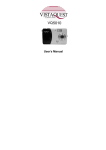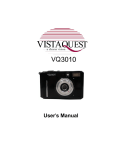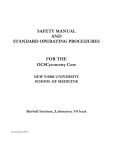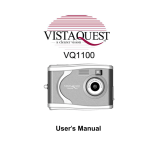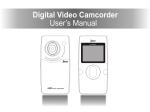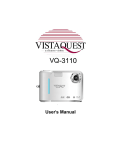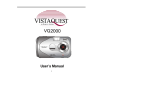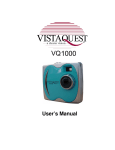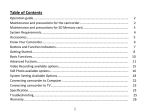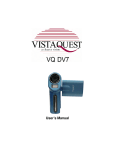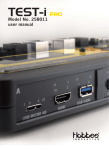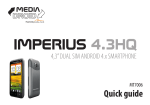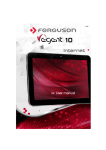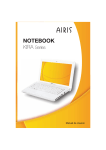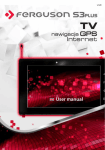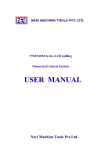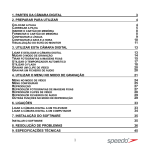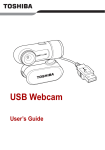Download VistaQuest VQ 5020 User's Manual
Transcript
User's Manual 020606 For customers in North and South America For customers in USA This device complies with Part 15 of the FCC rules. Operation is subject to the following two conditions: (1) This device may not cause harmful interference. (2) This device must accept any interference received, including interference that may cause undesired operation. For customers in Canada This Class B digital apparatus meets all requirements of the Canadian Interference-Causing Equipment Regulations. For customers in Europe “CE” mark indicates that this product complies with the European requirements for safety, health, environment and customer protection. “CE” mark cameras are intended for sales in Europe. Table of Contents 1. System Requirements ----------------------------------------------------------2. Package Contents ---------------------------------------------------------------3. Quick Start -------------------------------------------------------------------------4. Name of Parts ---------------------------------------------------------------------5. Display Information -------------------------------------------------------------6. Getting Started --------------------------------------------------------------------• Installing Camera Batteries ---------------------------------------------------• Inserting SD Card (Optional) -------------------------------------------------• Turning On the Camera --------------------------------------------------------• Setting the Date, Time and Date Stamp -----------------------------------• Power Saving ---------------------------------------------------------------------7. Taking Pictures --------------------------------------------------------------------• Taking a Picture ------------------------------------------------------------------• Taking Continuous Pictures ---------------------------------------------------• Using Digital Zoom --------------------------------------------------------------• Using Flash Light ----------------------------------------------------------------• Setting Picture Quality ----------------------------------------------------------• Adjusting the Exposure ----------------------------------------------------------• Taking the Picture in Self-timer Mode ----------------------------------------8. Taking Videos ----------------------------------------------------------------------• Taking a Video --------------------------------------------------------------------9. Reviewing Pictures and Videos ----------------------------------------------• Reviewing Pictures and Videos ----------------------------------------------• Viewing Six Pictures ------------------------------------------------------------• Using Slide Show ----------------------------------------------------------------• Magnifying Pictures -------------------------------------------------------------- Page 1 1 2 4 6 7 7 7 8 8 9 10 10 10 11 11 12 13 13 14 14 15 15 15 16 16 Table of Contents • Selecting Pictures for Printing (DPOF Print Settings) ------------------10. Deleting Pictures and Videos -----------------------------------------------• Deleting Single Picture or Video ---------------------------------------------• Deleting All Pictures and Videos ---------------------------------------------• Formatting Internal Memory or SD Card -----------------------------------11. Customizing Your Camera Settings ---------------------------------------• Capture Function Menu ------------------------------------------------------• Playback Function Menu -----------------------------------------------------12. Installing Your Camera Driver and Software -------------------------------13. Uninstalling Software -----------------------------------------------------------• Uninstalling Software -----------------------------------------------------------• Uninstall Camera's Driver ------------------------------------------------------14. Mass Storage & Direct Print ---------------------------------------------------15. Downing Images to Your Computer -------------------------------------------16. ArcSoft PhotoImpression 5 --------------------------------------------------17.ArcSoft VideoImpression 2 -------------------------------------------------------18. Using the Camera in PC Cam Mode -------------------------------------------19. Checking the Connection of Your Camera ---------------------------------20. Internet Video Conference -----------------------------------------------------Appendix --------------------------------------------------------------------------------Specifications -----------------------------------------------------------------------FAQ -----------------------------------------------------------------------------------Troubleshooting --------------------------------------------------------------------- Page 17 18 18 18 19 20 20 25 27 28 28 28 29 30 31 32 35 36 37 38 38 39 41 1. System Requirements • Personal computer, laptop, desktop, or IBM compatible with Pentium 166 MHz minimum, and with an active USB (Universal Serial Bus) port. • Windows 98 SE / ME / 2000 / XP, CD ROM drive, color monitor, mouse and keyboard. • Color printer for printing color pictures. • For transferring still images via the Internet, or for video conferencing, your computer must have modem and communication software for Internet connection. 2. Package Contents Make sure that all of the items shown below are included with your VQ5020. • VQ5020 digital camera • USB cable • Video cable • Pouch • Wrist strap • Installation CD • User’s guide -1- 3. Quick Start CAUTION Please install the camera driver before using your camera with a PC. Best way to transfer picture to PC is using the PC-DISK (Mass Storage) mode to copy all your pictures. • Getting Ready 1. Slide open the battery compartment cover. 2. Load the batteries into the camera. 3. Slide close the battery compartment cover. 4. Load the SD card (Optional) into the camera. • Taking a Picture 1. Turn on the camera. 2. Slide the Function switch to . (Capture Status) 3. Point the camera at the subject, use the TFT to compose the picture. 4. Hold the camera still, gently press the shutter button to take a picture. -2- • Reviewing a Picture 1.Turn on the camera. 2.Slide the Function switch to (Playback status). 3.Push the joystick up or down to scroll through the pictures or videos on the TFT. • Deleting a Picture 1. Turn on the camera. 2. Slide the Function switch to (Playback Status). 3. Push the joystick up or down to display the picture you want to delete. 4. Press the DELETE button to turn on the menu, and then push the joystick up or down to select [DeleteOne] on the screen. Press the joystick button to confirm. -3- 4. Name of Parts The following illustrations show the names of each component, button, and switch on the camera. 1. Shutter Button 2. Power (ON/OFF) Button 3. Flash 4. Indicator Lamp 5. Lens 6. Microphone 7. Focus Switch 8. USB Port Terminal & TV Out Terminal 9. Function Switch 10. Power Lamp 11. Strap Eyelet 12. Buzzer 13. MENU Button /MODE:Down/Mode / : Up/Flash / : Left/Zoom Out / : Right/Zoom In 14. DELETE Button 15. Joystick 16. TFT (panel) 17. Tripod Socket 18. SD Card Socket 19. Battery Compartment Cover -4- Indicators 1. Indicator Lamp 2. Self-Timer Lamp 3. Power Lamp 4. Flash Digital Interface: USB 1.1 Video Output: TV out in NTSC / PAL DIGITAL ZOOM During shooting, user can push the joystick left or right to zoom in and zoom out. Display Button When in capture and video status, press the joystick and the information on the TFT will be switched off. Press the joystick again the TFT will be turned off. Press the joystick the third time, the TFT and the information will on at the same time. Menu Button You can turn the menu ON or OFF by pressing the Menu button. As menu turn on, the items appear, Push the joystick up or down to select the item, and then press the joystick to enter the submenu. Push the joystick up or down to select the item and press the joystick to confirm. -5- 5. Display Information Note: If the icon appears on the LCD when you take pictures in dark conditions. Please keep your hands steady, otherwise you may capture a blur picture. -6- 6. Getting Started • Installing Camera Batteries: 1. Slide open the battery compartment cover. 2. Insert batteries. Be sure to load batteries with + and – terminals as shown on the camera. 3. Slide close the battery compartment cover. • Inserting SD Card (Optional): The VQ5020 offers two options for storing pictures and videos: Internal Memory - Store pictures and videos in the 16 MB internal memory. SD Card - Optional SD cards provide removable, reusable storage for pictures and videos. Store as many pictures as you like, depending on the size of the card. CAUTION: • The card can only be inserted one way; forcing it may damage the camera or card. Do not insert or remove a card when power is on. To insert an SD card: 1. Turn the camera off. 2. Position the card as shown. Push the card into the slot until it hooks up. 3. To remove the card gently push the card until it get released from the hooking mechanism. After it has pooped out pull it out completely. -7- Note: 1. If the SD card is present in the camera, and then the picture/ video will save in the SD card. If no card is installed, the camera uses internal memory. 2. If the “MEMORY FULL” warning message appears on the TFT, it means the SD card or internal memory is full. Please remove the memory and insert a new one or move/store all the pictures/videos in memory to your computer. • Turning On the Camera: 1. Press the Power button on as shown in the illustration. 2. Buzzer will beep and indicator lamp will light. The TFT will be turned on. 3. Press the Power button again to shut down the camera. • Setting the Date, Time and Date Stamp: You should set the Date and Time when you first use your VQ5020 or the battery is removed for an extended time (approximately 120 Seconds). Use the following procedure to change the date and time setting. 1. Slide the Function switch to (Capture Status). 2. Press the MENU button to turn on function menu. Push the joystick up or down to select [Advance] item, and then press the joystick to enter the advanced menu. 3. Press the joystick up or down to select [Date Time], and then press the joystick to enter the submenu. -8- 4. Press the joystick up or down to adjust the date and time. Press the joystick left or right to adjust to the next setting. 5. When finished, press the MENU button to exit the menu. Use the Date Stamp setting to imprint the date on your pictures. 1. In the Date Time Setting menu. Make sure the camera clock is set to the correct date. 2. Push the joystick left or right to select [Date stamp] option. 3. Press the joystick to switch the Date stamp function to on (tick on) or off (tick off). 4. Press the MENU button to exit the menu. • Power Saving: The camera will automatically power off approximately 3 minutes after you do not perform any operation. When this function is disabled, the power is not turned off automatically. -9- 7. Taking Pictures • Taking a Picture 1. Turn on the camera. 2. The TFT will display image and symbols. 3. Slide the Function switch to (Capture Status). 4. The TFT will display (Snapshot Mode). If icon is different, Press the joystick down until the icon appears on the TFT. 5. Point the camera at the subject, use the TFT to compose the image. (If turn the switch to Macro , you can take picture as close as 19.5cm; If turn the switch to Portrait , you can take picture as close as 0.95m to 1.95m.) 6. Holding the camera still, gently press the Shutter button to take the picture. Note: How to take a good shot? After pressing down shutter button, keep your hand steady for 2 seconds to get best result. • Taking Continuous Pictures 1. Make sure the Function switch is set to (Capture Status) 2. Press the joystick down until appears on the TFT. (Continuous Mode) 3. Point the camera at the subject, use the TFT to compose the image. 4. Holding the camera still, gently press the shutter button to take the pictures Note: Flash is deactivated at this mode. You will see the icon - 10 - on the TFT. • Using Digital Zoom The Digital Zoom provides up to 4X magnification of your pictures. You may notice a decrease in printed image quality when using Digital Zoom. 1. Make sure the Function switch is set to Use the TFT to frame your subject. ( ) Button: The subject will be enlarged. 2. ( ) Button: The subject will be reduced. Push the joystick Right to zoom in. Keep the button pressed for continuous magnification. The TFT displays the zoomed image and the magnification level. 3. Push the joystick left to zoom out. 4. Press the Shutter button to take the picture. Note: 1. The image will appear grainier as the image is digitally zoomed. 2. Digital Zoom is automatically turned off when the camera is turned off. • Using Flash Light When you take pictures at night, indoors, or outdoors in heavy shadows, you can use the flash. Press the joystick up repeatedly to scroll through the flash options. The flash icon that is displayed on the TFT is the active option. Off—flash never fires. (Default) Auto Flash—flash fires when the lighting conditions require it. Force Flash—flash fires every time when you take pictures, regardless of the lighting conditions. - 11 - Red-eye—flash fires once so the subject’s eyes become accustomed to the flash, then fires again when the picture is taken. The Red-eye option remains in effect until you change it. Note: 1. All flash options revert to Off when the camera is turned off. 2. Flash is off during continuous mode and video mode. 3. This setting remains until you change it. • Setting Picture Quality Use the Quality setting to select a picture resolution: 1. Make sure the Function switch is set to , and then press the MENU button. 2. Push the joystick up or down to select [Size] and then press the joystick. 3. Select an option with or : L 12Mpix — for enlarged picture size; produces higher picture resolution and larger file size. M 5Mpix — for standard picture size; produces normal picture resolution and middle file size. S 3Mpix — for small picture size; pictures are of lower resolution and file size is smaller. 4. Press the joystick to confirm. Note: 1. This setting remains until you change it. 2. Movies can be shot with the QVGA (320 x 240) or VGA (640 x 480) resolution. - 12 - • Adjusting the Exposure Set the exposure value (EV value) manually to compensate for certain lighting conditions including: backlighting, indirect lighting, and dark backgrounds. 1. Make sure the Function switch is set to , then press the MENU button. 2. Push the joystick up or down to select [EV] and press the joystick button. 3. Push the joystick up or down to change the exposure value:-2.0 EV ~+2.0 EV. 4. Press the joystick button to confirm. • Taking the picture in Self-timer mode The Self Timer creates a default delay between the time you press the Shutter button and the time the picture is taken. This setting is ideal when you want to include yourself in the picture. 1. Make sure the Function switch is set to . 2. Push the joystick down until appears on the TFT. (Self-Timer Mode) 3. Place the camera on a flat surface or use a tripod. 4. Compose the picture, then press the Shutter button all the way down. 5. The red Self Timer light, located on the front of the camera, blinks for 10 seconds before the picture is taken. - 13 - 8. Taking Videos • Taking a Video 1. Turn on the camera. 2. The TFT will display image and symbols. 3. Slide the Function switch to (Video Status). And you will see the icon appears on the TFT. 5. Frame your subject on the TFT, and then press the Shutter button to take the video. 6. Press the Shutter button again to stop recording. Note: 1.During recording, user can press the / button to zoom in/out. 2.The video resolution is QVGA (320 x240) and VGA (640 X 480). 3.You can select video resolution use the [Size]. - 14 - 9. Reviewing Pictures and Videos • Reviewing Pictures and Videos 1. Turn on the camera. 2. Slide the Function switch to (Playback status). The last picture or video is displayed. 3. Push the joystick up or down to select the picture or video (If appears on the TFT panel) you want to review. 4. Press the joystick to start to playback the video. 5. During the playback, press the joystick pause/resume the video playing. Note: You can push the joystick left or right to enlarge or reduce picture. (Videos cannot be enlarged) • Viewing Thumbnail View thumbnail at once on the TFT (Index View) so that you can search the picture quickly. 1. Make sure the Function switch is setting to , and then press the MENU button. 2. Push the joystick up or down to select View on the screen and press the joystick button. 3. Push the joystick up or down to select ([Thumbnail]) and press the joystick button. 4. Six picture thumbnails appear on the TFT. 5. Push the joystick left or right to select the previous or the next picture, push the joystick up or down to enter the next page. Press the joystick on the picture you want to see in the whole screen. - 15 - • Using Slide Show Use the Slide Show feature to sequentially display your pictures and videos on the camera TFT, on a television screen, or on any external display device equipped with a video input. 1. Make sure the Function switch is set to , and then press the MENU button. 2. Push the joystick up or down to select [View] on the screen and press the joystick. 3. Push the joystick up or down to select [Slide Show] and then press the joystick. 4. Each picture and video thumbnail is displayed once, in the order in which you took them. 5. After slide show finished, It’s auto out of Slide Show function and then show last picture in playback mode. Note: If you want to run the slide show on a television, connect the video cable to the video-out port on the camera and the video-in port on the television. Ensure that the Video Out setting is correctly set to NTSC or PAL. • Magnifying Pictures Use the Magnify feature to zoom in to different areas of the picture. 1. Make sure the Function switch is set to . 2. Push the joystick up or down to select the picture you want to enlarge, and then press the MENU button. - 16 - 3. Push the joystick up or down to select [Zoom] on the screen and press the joystick. 4. The frame (approximate location of the magnified area) appears on the TFT. Push the joystick to select location of the magnified area and press the joystick. 5. The picture is displayed at 2X magnification. Push the joystick to navigate to different parts of the picture. 6. Press the joystick button to redisplay the picture at the original size. Note: Videos cannot be enlarged. • Selecting Pictures for Printing (DPOF Print Settings) 1. Make sure the Function switch is set to . 2. Push the joystick up or down to select the picture you want to print, then press the MENU button. 3. Push the joystick up or down to select [Print] on the screen and press the joystick. 4. For setting images one by one: Push the joystick up or down to select ([Print One]), and then press the joystick to set current picture for printing with DPOF. • For setting all images on the SD card: Select ([Print All]) to set all pictures for printing with DPOF. 5. The checkmark appears on the TFT. 6. You can use the DPOF print settings to print with an optional direct print function compliant printer. (Refer to your printer User’s Guide for details.) Note: The DPOF printing feature support SD card only. - 17 - 10. Deleting Pictures and Videos Delete item allow user to delete current or all the stored images from the internal memory or SD card. • Deleting Single Picture or Video 1. Turn on the camera. 2. The TFT will display image and symbols. 3. Slide the Function switch to (Playback Status). 4. Push the joystick up or down to select the picture or video you want to delete, and then press the DELETE button to turn the menu on. 5. Push the joystick up or down to select ([DeleteOne]), and then press the joystick to delete the picture or video. • Deleting All Pictures and Videos 1. Make sure the Function switch is set to , and then press the DELETE button. 2. Push the joystick up or down to select ([DeleteAll]), and then press the joystick button to delete all pictures or videos. 3.Then the “NO PICTURE” warning message appears on the TFT. Note: 1. If all files (Photos and videos) are erased, the message “No Picture” appears on the TFT. 2. Files that are erased cannot be recovered. Make sure you have selected the images you want to erase. - 18 - • Formatting Internal Memory or SD Card 1. Make sure the Function switch is set to , then press the DELETE button. 2. Push the joystick up or down to select ([Format]), and then press the joystick to format Internal Memory or SD card. 3. Then the “NO PICTURE” warning message appears on the TFT. Note: Formatting memory permanently erases the contents of memory. Photos and video cannot be recovered from memory after formatting. Transfer any files that you want to keep to a computer before formatting memory. - 19 - 11. Customizing Your VQ5020 Settings Capture Function Menu When user slide the Function switch to (Capture Status). Press the MENU button can turn ON/OFF function menu. Push the joystick up or down to select items, press the joystick to enter the submenu, and then push the joystick up or down to change the current selected setting. Press the joystick to confirm. Push the joystick left to return to main menu, press the Menu button to cancel the setting and return to capture status. [White Bal]: (White Balance) When the white balance is set to match the light source, the VQ5020 can take picture more accurately. Auto (*) The camera sets the white balance automatically according to shooting conditions. Daylight Using when shooting at outdoors in sunlight on a clear day. Cloudy Using when shooting at outdoors and the sunlight is not enough such as under cloudy sky, shade or dusk. Tungsten For recording under tungsten lighting. Fluorescent For recording under fluorescent lighting. (*): Default - 20 - [Exp Val]: (Exposure Value) Exposure compensation lets you change the exposure setting (EV value) manually to adjust the lighting of your subject. This feature helps to achieve better results when recording a backlight subject, a strongly light subject indoors, or a subject that is against a dark background. 1. Push the joystick up or down to adjust the compensation. 2. Press the joystick to confirm. • The settings can be adjusted in 1/2 steps within the range -2 and +2. • You can check the result of the compensation by viewing the image on the TFT. [Size]: (Picture Size) You can change the picture size settings to suit your purpose. L (Large) 12Mpix for enlarged picture size; produces higher picture resolution and larger file size. M (Medium)(*) 5Mpix for standard picture size; produces normal picture resolution and middle file size. S (Small) 3Mpix for small picture size; produces lower picture resolution and smaller file size. VGA 640x480 for large video size; produces high picture resolution and large file size. QVGA 320x240 for small video size; produces low picture resolution and small file size. - 21 - [Advance]: Select Advance Option to bring up the following advanced menu. Push the joystick up or down to select [Advance] menu. Press the joystick to enter the submenu, push the joystick up or down to select the function you want to set, Press the joystick to confirm, and then push the joystick up or down change the currently selected setting. Press the joystick to confirm the setting. Push the joystick left to return to main menu. Press the Menu button to cancel the advance menu and return to capture status. (*): Default Beeper: ON Setting the beep sound to on. (*) OFF Setting the beep sound to off. Auto Power Off: ON Setting the camera automatically powers off approximately 3 minutes after the last function is accessed. OFF Stopping the camera automatically powers off function. Quick Review: ON Setting the quick review feature to on. OFF Setting the quick review feature to off. (*) - 22 - Timer: 10 Sec Setting the timer in self-timer mode to 10 second. (*) 15 Sec Setting the timer in self-timer mode to 15 second. 20 Sec Setting the timer in self-timer mode to 20 second. Quality: Normal Setting the picture quality to normal. (Small file size) Fine Setting the picture quality to standard. (*) Best Setting the picture quality to fine. (Bigger file size) TV: PAL Setting the TV mode to PAL. (*) NTSC Setting the TV mode to NTSC. Language: English Setting the language to English. (*) Italiano Setting the language to Italian. Polski Setting the language to Polski. Deutsch Setting the language to German. Français Setting the language to French. Español Setting the language to Spanish. Nederlands Setting the language to Dutch. Setting the language to Japanese. Setting the language to Chinese. Português Setting the language to Portuguese. - 23 - Flicker: 50Hz Setting the flicker frequency to 50 Hz. (*) 60Hz Setting the flicker frequency to 60 Hz. Date Time: YES Setting the Date / Time. Reset: YES Setting all the functions to default. - 24 - Playback Function Menu When you slide the Function switch to (Playback Status). (*): Default [Delete]: Delete item allow user to delete current or all the stored images from the Memory. Press the Delete/Shutter Button can turn ON/OFF the Delete menu. Push the joystick up or down to select items and then press the joystick to confirm. Press the menu to return to playback status. Delete One Select “Delete One” to delete (erase) current picture or video. Delete All Select “Delete All” to delete (erase) all pictures or videos. Format Select “Format” to format the flash memory or SD card. [View]: Default setting of the playback mode displays one picture in the TFT screen. Pressing Menu button can turn ON/OFF the Edit menu. Push the joystick up or down to select items and then press the joystick to enter the submenu, and then push the joystick up or down to select the item and then press the joystick to confirm. Push the joystick left to return to the main menu. Press the Menu button to cancel the advance menu and return to playback status. Single Select “Single” to Display one picture. Thumbnail Select “Thumbnails” to display six pictures. Slide Show Select “Slide Show” to slide show. - 25 - User can select to show the thumbnail, and a blue-frame indicates the current picture that is selected, just press the joystick to fill (enlarge) the picture in screen. Push the joystick left or right to jump previous/next picture, push the joystick up or down to switch the page. Once the user selects the Slide Show Mode, camera will automatically play all the pictures. [Print] (DPOF): Select this item to bring up the printing option. Print One Select “Print One” to print current picture. Print All Select “Print All” to print all pictures. Cancel One Select “Cancel One” to cancel print setting of current picture. Cancel All Select “Cancel All” to cancel print setting of all pictures. [Zoom]: In Zoom item, push the joystick up, down, left or right to select the area of interest, and then press the joystick to enlarge zoom area to whole screen. Press the joystick to cancel the Zoom. Zoom Select “Zoom” to magnify different parts of the pictures. - 26 - 12. Installing Your Camera Driver and Software • Installing Driver 1. Turn on the computer. 2. Insert installation CD into the CD-ROM drive and the installation CD menu will appear. 3. When you see the following screen, choose “Camera Driver”. 4. Follow the on-screen instructions. 5. Restart the computer. For Windows 2000/XP only: During installation of the driver or software, computer may display the message: “The software you are going to install doesn’t contain the Microsoft signature, and may not work correctly. Do you want to continue? Y / N” Please select Y to continue the installation. • Installing Software 1. Insert installation CD into the CD-ROM drive and the installation CD menu should appear. 2. When you see the following screen, choose “Arcsoft Software” to install the software. 3. Follow the instructions on screen. 4. Installed software will automatically create “VideoImpression 2” or “PhotoImpression 5” logo on your desktop. - 27 - 13. Uninstalling Software Following instruction will guide you to uninstall (remove) software from computer. • Uninstalling Software 1. Click "Start" from the task bar and choose "Settings" -> "Control Panel". (For Windows XP: "Start" -> "Control Panels") 2. Double click "Add/Remove Programs". 3. Select the program to be uninstalled: "ArcSoft Software Suite". 4. Click on "Remove Program" (For Windows 2000/XP: Change /Remove") and then "OK". • Uninstall Camera's Driver 1. Click "Start" from the task bar and choose "Settings" -> "Control Panel". (For Windows XP: "Start" -> "Control Panels"). 2. Double click "Add/Remove Programs". 3. Select the program to be uninstalled "Digital MultiCam II Digital Camera” and “Digital MultiCam II Video Camera". 4. Click on "Remove Program" (For Windows 2000/XP: "Change /Remove") and then "OK". - 28 - 14. Mass storage & Direct Print 1.Mass storage: You can download the pictures in the camera to your computer. 2.Direcr Print: You can print directly to USB port printer. You need: Camera with batteries USB port printer USB cable included with your camera • Slide the Function switch to (Playback Status). • Connect USB Cable with printer and digital camera. Turn on your camera. • The pop up menu will appears and allowing selection of Mass Storage or Direct Print function. Push the joystick to select the function you want to set: Press the joystick to enter Mass storage mode. The “Mass Storage” message appears on the LCD monitor. (see next page) Press the joystick to enter Direct Print menu. The last picture is displayed on the LCD monitor. • Push the joystick up or down to select the picture you want to print, then push the joystick left or right to choose a printing option. Fixed : "4 x 6" or "5 x 7". Print : Printing picture Press the joystick to switch or confirm the item. • Turn off the camera and printer. • Disconnect the USB cable from the camera and the printer. Note: You must install your camera driver. - 29 - 15. Downloading Images to Your Computer For Windows 98/me customers: Please install camera drive before connecting. 1. Turn the camera and computer on, then connect the camera to the computer with the included USB cable, and then slide the Function switch to (Playback Status) 2. “USB Mass Storage drive” appears on the computer screen. For Windows XP: A dialogue box with options appears as shown on the Right side. The options are Play, Find/Fix/Share Images. Open folders to view files, take no action, Copy images to a folder on my computer, View a slide show of images, and etc. Please select one of them and click on “OK”. For Windows 2000/me/98: Double click on “My computer”, and then double click on Removable Disk (i:) in the DCIM files. (All the photos and videos are stored here). 3. Press “Ctrl+A” on the keyboard to choose all the photos/videos, then press “Ctrl+C” to copy photos, and then open a file in the computer, press “Ctrl+V” to paste the photos. - 30 - 16. ArcSoft PhotoImpression 5 ArcSoft PhotoImpression 5 is a complete digital image editing application designed with real people in mind. Easy-to-use “Getting Start” guides, user-friendly UI, complete image editing functionality, give users wonderful experience to organizing, viewing, enhancing, editing, printing and sharing photos. Click “Start” “Program” “ArcSoft Software Suite“ “PhotoImpression 5” to launch PhotoImpression 5 or double click PhotoImpression 5 icon on the desktop and you will see a window as the screenshot above. Select the picture source. For example: Click “Folder” for acquiring photos from your computer. Select the file path. You can start editing them. - 31 - 1. 2. 3. 4. 5. 6. Get Photo – Choose how to view or acquire photos. Enhance – Crop, brighten, rotate, resize and modify photos. Create – Add clip art, special effects, frames and more. Project – Make calendars, photo books and greeting cards. Print – Print multiple images per page and multiple pages at one time. Send – Email photos or upload them to online photo sharing accounts. Note: For more detailed information, please refer to the Help of the program. 17. ArcSoft Video Impression 2 ArcSoft VideoImpression 2 creates home movies and slide shows by combining existing videos, still images, exciting scene transitions, and multiple audio tracks. Though simple to use, the program provides intense and broad video editing and export options perfect for owners of digital still cameras, desktop and digital video cameras, and camcorders. Click “Start” “Program” “ArcSoft Software Suite“ “VideoImpression 2” to launch VideoImpression 2 or double click VideoImpression 2 icon on the desktop and you will see a window as the screenshot above. Open a Project – Let you browse the project files in the VideoImpression system folder. By “project,” we mean to say a file that contains all of the settings and each individual component on the Storyboard. When you - 32 - save your work as a project, you can go back and swap components, add and remove them, alter audio, etc. Create a Video – Create a new video project. You can retrieve media materials from the device connected or choose media files from system folder. You can choose video materials from your photo album as well. Create a Slide Show – Create a slide show project. You can retrieve media materials from the device connected or choose media files from system folder. You can choose slide show materials from your photo album as well. If the box “Always show this wizard when VideoImpression starts.” at the bottom of the wizard is checked, the wizard will appear each time you run the program. If you'd like to skip the wizard the next time, uncheck the box. Select the item you desire and the picture and videos you need then you will enter the editing interface as below. You can use the six steps in the Function Menu to create video clips and slide shows. - 33 - 1. Media - Select the videos and images that will comprise your final movie or slide show. 2. Edit - Modify video and image color and adjust the duration of each movie component. Only available for video projects. 3. Effects - Add neat special effect transitions between each component, or apply a pre-made theme. 4. Text - Place animated text on any movie component. Only available for video projects. 5. Narrate - Record audio directly from the program and add it to your movie. 6. Produce - Combine all components to create your final video; save it in a variety of ways or email it to friends. The Storyboard - The backbone of the creation process, it's where you assemble your movie. The Player - Preview and modify your movies in this area. Working with Albums - Albums let you organize your media for easy access. Note: For more detailed information, please refer to the Help of the program. - 34 - 18.Using the Camera in PC-Cam mode The VQ5020 offers two USB modes: Removable Disk and PC Camera. Note: Please install camera drive before you can use the camera in PC-Cam mode. Setting Up PC-Cam 1. Turn the camera power on and slide the Function switch to status). (Capture 2. Connect the camera and the computer use the USB cable. 3. There are many methods to view your image in PC-Cam mode if you have Video software. For example: A. Click NetMeeting Start Video. B. About Arcsoft software: a. PhotoImpression 5: Click “file” on the function menu an icon Click “Get photo” on the browse pane as shown on the right “Live”. b. VideoImpression 2: Click Create a new video Get from Album Capture Video. - 35 - 19.Checking the Connection of Your Camera For Windows 98/Me only Double click “My Computer” icon -> Control Panel -> System -> Device -> Manager -> Imaging Device; when you See “Digital MultiCam II Digital Camera” and “Digital MultiCam II Video Camera” that means now the camera is installed. For Windows 2000/Xp only Double click “My Computer” icon (Windows 2000) or go to Start button and select “My Computer” (Windows XP) -> Control Panel -> System -> Hardware -> Device Manager -> Imaging Device; when you see “Digital MultiCam II Digital Camera” and “Digital MultiCam II Video Camera” that means now the camera is installed. - 36 - 20. Internet Video Conferencing To run a video conference with another person, you and the other person must have the computer station configured with web camera, microphone, speakers, modem and have access to the Internet. You have to download video conference software, purchased or free, such as basic software like I-phone, Microsoft NetMeeting, or Yahoo Messenger. As example: to download Windows NetMeeting, go to www.microsoft.com search for NetMeeting and follow the download procedure. Starting NetMeeting, you have to follow the simple set up procedure on the computer screen, enter your personal information and adjust the microphone volume. Here's how video conferencing works: To receive video: 1.Call someone you want to see/hear. 2.On the Tools menu, point to Video, and then click Receive. If you have a video camera, you can send video to the person you are calling. To send video 1.Call someone you want to see/hear. 2.Click the Start Video button. Note: 1. You can also send video by clicking the Tools menu, pointing to Video, and then clicking Send. After starting the video, the button changes to Stop Video. To stop the video, click the Stop Video button again. 2. For software support, or detailed information how to work with PhotoImpression or VideoImpression – contact www.ArcSoft.com - 37 - Appendix: Image Sensor Output Lens Specification Focus Range Lens composition Optical Zoom Preview digital zoom Playback digital zoom Viewfinder Flash Strobe Flash light distance White Balance Exposure metering Exposure compensation Image Play Shutter Speed ISO Speed Still image format Still image size Movie Format Specifications Audio Microphone CMOS 2592 x 1944 Pixels (5.0M Pixels) Fixed focus lens, F 3.0, Focal length = 8.6 mm Macro : 20 cm, Portrait : 1m ~ 2m, Landscape : 2m ~ Infinity 5G(Include IR)(TBD) None 4X 4X None IGBT (Force On, Force Off, Red Eye Reduction and Auto) 0.5 ~ 1.5m Automatic / Daylight / Cloudy / Fluorescent Lamp / Tungsten Lamp Center weighted Automatic / Manual (-2EV to +2EV in 1/2 EV steps) Single Image, Thumbnails, Slide Show, Movie Clip 1/2 ~ 1/1500 Sec ISO Auto JPEG (DCF, Exif2.1) 12M --- 4000 x 3000 Pixel; 5M --- 2592 x 1944 Pixel; 3M --- 2048 x 1536 Pixel AVI(Motion JPEG) with digital zoom recording QVGA 320 x 240 Pixels Up to 50 sec (30 fps); VGA 640 x 480 Pixels Up to 20sec (20 fps) Yes (Buzzer) Yes RTC (Real-Time Clock) Yes Display 2.5” LTPS LCD RTC (Real-Time Clock) Yes PC Interface USB 1.1 TV interface NTSC/PAL Storage Built-in 16MB Flash Memory + SD Card Slot (Card Not Included) Battery AAA 1.5V Alkaline/Re-chargeable Batteries x 2 (not included) O/S Microsoft Windows 98 SE / 2000 / ME / XP Dimension (WxHxD) 89mmx56mmx24.5mm Bundled Software ArcSoft PhotoImpression 5 and ArcSoft VideoImpression 2 Movie Size(with Audio) - 38 - FAQ Q1: If I do not use batteries, can I use an USB cord and Adaptor and still take pictures with my VQ5020? A1: No, when taking pictures, it is important that you use batteries. Also, you have to remember to charge the batteries before operating your camera. Q2: I am not very familiar with VQ5020 and usually my pictures turn out blurred. Is there any way I can better focus my camera? A2: Yes, please locate the Macro Switch on the camera lens. Switch it to the Landscape ( ) setting unless taking close-up pictures in which case, you must switch to the Macro ( ) setting. Note: If the pointer is found anywhere in between these two symbols, it will adversely affect the focus. Also, ensuring there is enough lighting and that your hands are steady for one second after you press the Shutter Button will help with the focus. Q3: I have noticed that the pictures I have taken are all very dark. How can I make these pictures lighter? Should I use the flash often? A3: Avoid taking pictures in places with little lighting. When it is cloudy, please use other means to create more light before taking pictures. We recommend using the flash function during nighttime. During the day, the flash may be too strong and the picture may come out too bright, thus use it only during the night. - 39 - Q4: After I am done taking a picture, it takes a while for the picture to come up on the TFT . Is there something wrong with my camera? A4: No, with the camera, if you select a larger picture size, it will take longer for it to come up on the TFT. So if you want to speed things up, please select a smaller picture size. (M picture size is recommend) - 40 - Troubleshooting Problem Source Solution The camera is not running The power is not on • Press the Power button to turn the camera on. The batteries were not inserted properly • The correct direction to insert the AAA batteries is indicated on the camera. Batteries are depleted • Replace with unused alkaline or fully recharged batteries (two AAA-size batteries). The battery cover is not closed properly • Close the cover correctly and securely. The camera is not taking pictures. The camera is in the • Slide the function switch to Capture Playback Function mode Function mode. The flash is charging • Wait until the flash charges. You can press the shutter button when the indicator glows a steady orange. The SD card or internal memory is already full • Obtain a new SD card and insert it. • Download images to your computer, and then erase them from the card or format to free up more space. The SD card is not formatted correctly • Ask SD card manufacturer for assistance. - 41 - Problem Source Solution Picture is not clear The lens is dirty • Clean the lens. The pictures are blurred Hands were not steady when taking the picture • Ensure hands are steady when taking picture and remain steady one second after clicking the Shutter button. The picture subject was • Keep a minimum distance of 1.2 not in the focus range of meter between the picture subject the camera and the camera lens to stay in the focus range of the camera. The flash doesn't fire The flash mode is set to Off • Set the flash to any other mode except Off. The computer cannot communicate with the camera Camera power is off • Turn on the camera. USB cable is not securely connected • Connect cable to camera and computer port. Driver is not installed (for • Install the camera driver. Windows 98 user) The PC Camera doesn't work C Camera power is off • Turn on the camera. USB cable is not securely connected • Connect cable to camera and computer port. Driver is not installed • Install the camera driver. 2006 Vistaquest corporation - 42 - www. vistaquestusa.com














































